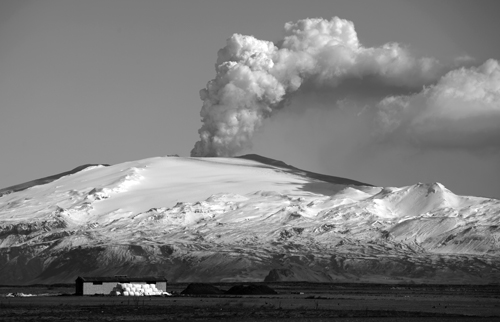Scientists split on geological implications of volcano in Iceland

Seen from near Hvolsvollur, Iceland, a plume of ash and dust from a volcano erupting beneath Iceland’s Eyjafjallajokull glacier towers into the sky on Wednesday.
By Nouschka van der Meijden
April 22, 2010 10:02 p.m.
Following the eruption of an Icelandic volcano on April 15, an article in the magazine New Scientist proposes that Iceland may be entering a so-called active phase, where multiple eruptions could occur over the next 60 years. Many scientists, however, disagree with this hypothesis.
The eruption of Eyjafjallajökull was an event on its own and not related to a general increase in activity underneath Iceland, said Axel Schmitt, geologist in UCLA’s earth and space sciences department. Schmitt, who is currently in Germany, has been prevented from returning to UCLA, as flights out of many European countries have been grounded because of volcanic ash clouds.
Dr. Fred Prata, an Australian atmospheric research scientist, said he agrees Iceland has not entered an active phase. Prata, who was scheduled to give a guest lecture on this topic, said he and other experts do not believe volcano activity is generally regular, and therefore do not believe it can be narrowed down to active and inactive phases.
The article published in New Scientist only takes into account those eruptions that were explosive and produced large amounts of ash, Schmitt said. He added that smaller eruptions, called basalt flows, were not used in the calculations and therefore the study cannot create an accurate prediction of future volcanic action.
Even though Iceland may not enter an official active phase, other eruptions could still take place in the coming months, Schmitt said. The main threat comes from Eyjafjallajökull’s neighboring volcano, Katla. Eyjafjallajökull has erupted twice before, in 1612 and between 1821-1823, and every time, Katla followed within several months.
Theories suggest that the volcanos share the same magma body, meaning that pressure would increase for both volcanoes at the same time, Prata said.
It could be that Eyjafjallajökull will erupt again in the coming months, but whether or when this would occur is complicated to determine.
“When tension increases under a volcano, its dome inflates until it erupts and the pressure is released,” Prata said. “Eyjafjallajökull is now deflating, but we do not know what caused the initial tension. If the cause of the pressure remains, the volcano could erupt again.”
Also, since Eyjafjallajökull lies beneath a glacier of the same name, any inflation of the dome is invisible on the surface. This makes predictions complicated and the volcano’s eruptive behavior unique.
“The eruption progressed to an explosive level because of the interaction between magma and water and ice,” Schmitt said.
Iceland’s high volcanic activity is due to its location above a hot spot in the Earth’s interior. In addition, it is situated on top of a boundary between two plates that are being pulled apart, causing the crust to constantly deform.
In such a weak zone, volcanic eruptions occur with high frequency. Iceland has 30 volcanoes that have been active over the past 10,000 years, Schmitt said.
If other eruptions occur, they will not necessarily have the same disruptive effect as Eyjafjallajökull, since the consequences depend on the magnitude of the eruption, the density of the air and the height the ash reaches.
Another volcano to keep an eye on in Iceland is the highly active Hekla, which erupted in 1980, 1991 and 2000 and can therefore be expected to erupt again soon. Hekla’s activity, however, is independent of Eyjafjallajökull.

